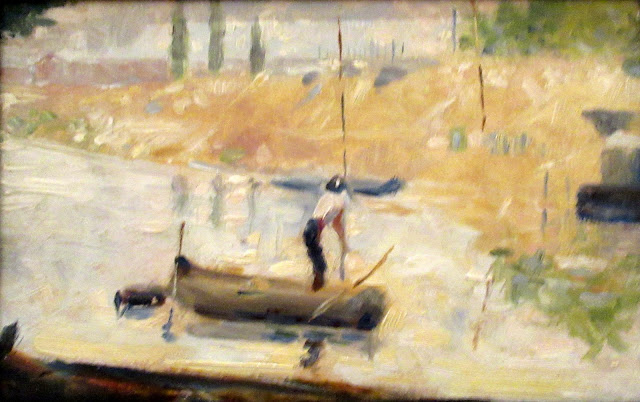Impressionism and Post-Impressionism, 1880-1900, at the Courtauld.
These movements changed the course of art. Impressionists such as Claude Monet and Pierre-Auguste Renoir created new ways of painting modern life and landscape, conveying the immediate experience of light and atmosphere. Embracing the liberating character of Impressionism, Post-Impressionist painters such as Vincent Van Gogh, Paul Cezanne, Paul Gauguin and Georges Seurat went further; their bold brushwork and expressive use of colour were a major influence on artists throughout the 20th century.
Paul Cezanne, Lac d'Annecy, 1896, (oil on canvas)
Paul Cezanne, The Card Players, 1892-96, (oil on canvas)
Cezanne spent several years drawing and painting farm workers from the rural estate where he lived in the South of France. His figures are elongated, somewhat out of proportion. However, the overall feeling is one of stillness and concentration, with the men completely absorbed in their game. Before Cezanne, artists and illustrators often represented card playing as a rowdy activity in taverns with wine and beer flowing. This painting offers a different vision: Cezanne's labourers are monumental and dignified, like time worn statues.
Paul Gauguin, The Haystacks, 19889, (oil on canvas)
A radically simplified approach to painting - forms are rendered as flat patches of vibrant colour, while three-dimensional relationships and perspective are deliberately ignored. Gauguin reduces the peasant women raking hay to the basic shapes of their black-and-white regional dress, presenting their actions as a timeless ritual.
Edouard Manet, Banks of the Seine at Argenteuil, 1874, (oil on canvas)
The bright colours and swift brushstrokes creating the ripples on the water show Monet's influence. However, Manet maintained his distinctive use of thick oil paint and rich blacks to give weight to the painting.
Edouard Manet, Au Bal, 1877, (oil paint on canvas)
Edouard Manet, A Bar at the Folies-Bergere, 1882, (oil on canvas)
The most important painting in the collection in my view, and one of my favourites of all time. It's a painting that has been written about extensively, a painting full of mystery.
A complex and absorbing composition that is considered one of the iconic paintings of modern life. It's a painting that is full of ambiguity and doubt, a painting of surfaces while being flat, and it's also about class relations.
I wrote about this in this blog a few years ago and you can see the analysis here
Vincent Van Gogh, Peach Trees in Blossom, 1889, (oil on canvas)
Van Gogh captured this view of an open plain outside Arles in early spring 1889. He wrote to his brother that the blossoms and the distant snow-capped mountain reminded him of the cherry trees and Mount Fuji in the Japanese prints he collected and greatly admired.
Self-Portrait with Bandaged Ear, 1889, (oil on canvas)
This famous self-portrait by Van Gogh expresses his artistic power and personal struggles. He painted it in January 1889, a week after leaving hospital. He had received treatment there after cutting off most of his left ear. This self-mutilation was a desperate act committed a few weeks earlier, following a heated argument with Paul Gauguin.
The fur cap secures his thick bandage and wards off the winter cold. Created in harsh conditions, this self-portrait demonstrates Van Gogh's determination to continue painting, reinforced by the objects behind him: a canvas on an easel and a Japanese print, an important source of inspiration. Above all, it is Van Gogh's brushwork and powerful handling of colour that declare his renewed ambition as a painter.
Georges Seurat, The Bridge at Courbevoie, 1886-87, (oil on canvas)
Seurat used pointillism, the technique that entails placing coloured dots side by side to create an image, instead of mixing colours on a palette, for this painting. New optical theories at the time suggested that this made the surface of the painting more vibrant. However, the overall effect is one of melancholy and stillness, emphasised by the vertical trees and masts of the boats.
Georges Seurat, Beach at Gravelines, 1890, (oil on wood)
This nearly abstract seascape is rendered with only a few colours, the separation between water and sky barely marked by the strip of orange in the centre.
Georges Seurat, Man in a Boat, 1884, (oil on wood)
Paul Gauguin, Nevermore, 1897, (oil on canvas)
Intended for a white European male audience, this image of a reclining nude belongs to a long artistic tradition. To the familiar theme however, Gauguin added a sense of exoticism and of unease. The young woman - or should I say, child - is not at rest but looks anxious. Her youth is the nost disconcerting aspect. She is sometimes identified as Paul Gauguin's 15-year old companion Pahura.
Gauguin took advantage of his position as a European coloniser. Pahura was one of several teenagers that he took on as 'wives'. The widespread racist and sexist fantasy of Tahitian girls as sexually precocious led to clear exploitation.































































